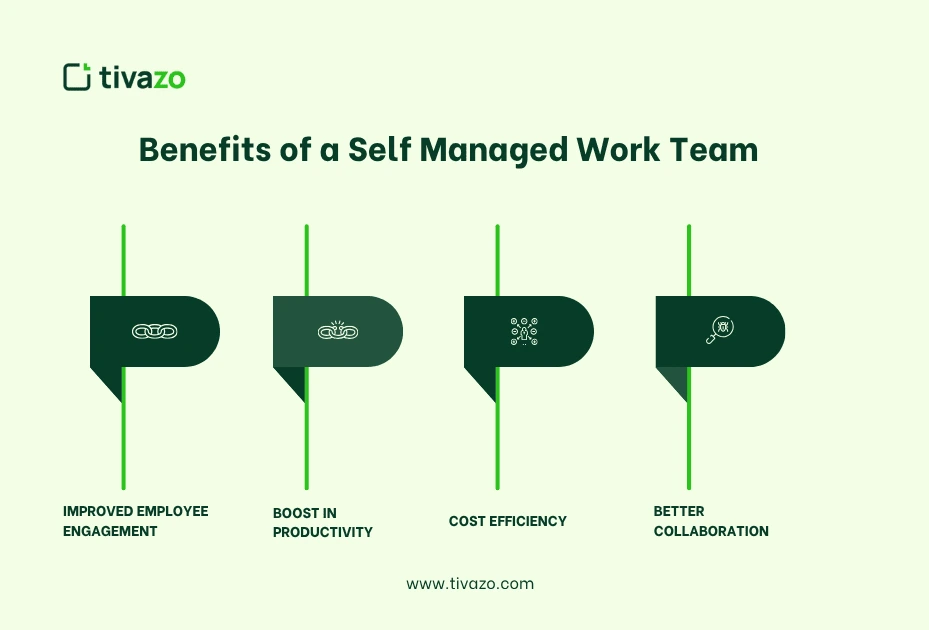Have you ever asked yourself how some companies are successful even when left alone? Maybe there are workers who do best when they manage every aspect of their roles. The solution is found in the self managed work team.
Because nowadays flexibility, agility, and teamwork count the most, organizations are turning to self-managed teams. No matter the size of a company, this model is improving how workers feel involved and get their jobs done.
But what do we mean when we say a self-managed work team? How do they achieve their tasks? How can you carry out a new project plan in practice?
Let’s go through all the required details and uncover some additional facts not mentioned in other articles.
Key Highlights:
- Advantages of a Self Managed Work Team
- Benefits of a Self Managed Work Team
- Disadvantages of Self-Managed Teams
- How to Build a High-Performing Self Managed Work Team
- The Role of AI in Supporting Self-Managed Teams
What Is a Self Managed Work Team?
A self managed work team is a group of employees who manage themselves without direct supervision. Members of these teams are responsible as a group for planning, preparing schedules, assigning tasks, handling problems, and deciding what to do.
Indeed states that self-managed teams are separate from traditional teams, as they are independent and don’t rely on a manager telling them what to do every day.
All in all, the team is in control and things work smoothly as long as it’s done right.
How Do Self Managed Teams Work?
In self managed work team , decision-making and responsibility are spread among all team members equally instead of being the sole duty of one manager. Each person on the team handles their assignments and helps the group to decide goals, address problems, and follow developments. Decentralized management leads to quick changes, and easy innovation and keeps the team unified through open talks and every person being responsible for their actions.
In real life, members of self-managed teams determine their tasks, handle their work schedules, and rely on task boards and performance records to remain orderly and straightforward. Frequent discussions with each other and sharing feedback support the team’s harmony and determination. Because of trust and independence, they are quicker to react to changes and can still deliver excellent results without being closely watched.
The opinion of industry experts is that teams who manage themselves need clear objectives, trust, and good teamwork. As these elements become part of the team, people join forces and boost the business by working together and feeling involved.
Advantages of a Self Managed Work Team

How can a self managed work team ensure maximum success? It’s not only because no one is supervising, but also because the company has clear goals, good habits, and strong structures that help everyone act responsibly.
Having these traits allows self-directed teams to do well in today’s fast-moving workplaces where collaboration is common. Let’s take a look at what essential traits a high-performing self-managed team has.
1. Autonomy in Decision-Making
Members of self-managed teams are allowed to make key decisions on their own, without often consulting people in higher management. With their freedom, employees are able to handle their work, overcome problems promptly, and adjust whenever necessary. If workers have independence in decision-making, they feel more confident and try out new things.
2. Shared Responsibility and Accountability
In a self managed work team, the work is shared among every team member. Every member needs to complete their work individually and help achieve the team’s common goals. Because of this self-driven system, peers show more support for each other, keep their goals the same, and feel closely tied to the team’s achievements.
You May Also Like: Using the Responsibility Assignment Matrix (RAM) to Master Your Projects
3. Role Flexibility
While traditional departments require people to stick to certain roles, self-directed teams encourage flexible roles among members. Sometimes, people on a team change roles, wear different hats, or help fill in wherever a project requires help. As a result, everyone keeps on learning, there is less chance of burnout and teams are able to adapt to new project tasks efficiently.
4. Peer Evaluation and Feedback
Usually, instead of having their performance reviewed from above, members of a self-managed team are assessed by their peers. Regularly discussing feedback keeps everyone informed which makes it easier to notice what went well or could be improved and enjoy team achievements. Such teamwork-based feedback encourages colleagues, boosts their trust in each other, and helps everyone aim for improvement.
5. High Trust Culture
Trust is what holds any successful self-managed work team together. Since there is no traditional manager, team members have to rely on each other to complete tasks, speak clearly, and fulfill their duties together. A trusting environment gives team members the confidence to discuss their thoughts, own up to error,s and help their team face difficulties.
Having these traits is crucial for any organization that wants to try self-management. Such characteristics turn teams into ‘agile’ systems, rather than fixed structures and this is where the real innovation starts.
Benefits of a Self Managed Work Team

1. Improved Employee Engagement
It is reported by Forbes that companies that shift to self-managed teams notice a rise in how involved their workers become. Why? Employees become motivated when they trust themselves to manage their work.
If employees are engaged, they work more effectively, loyally support the organization and stick to their mission.
2. Boost in Productivity and Innovation
Managers should give their teams space to progress because it allows them to progress quicker. Runn.io mentions that in a decentralized environment, teams can meet changes faster and create new ways to address challenges.
3. Cost Efficiency
Cutting down on middle managers results in lower expenditures. It has been reported by McKinsey that 30% of costs can be saved if companies simplify their management systems.
You May Also Like: How to Avoid Cost Overruns Using Proven Strategies for SaaS Businesses
4. Better Collaboration
Being in a self-managed team promotes a feeling of belonging. Rather than carrying out orders strictly, they involve themselves actively with others. They make decisions quicker and more wisely because they use the variety of skills in the team.
“Alone we can do so little; together we can do so much.”
— Helen Keller
Disadvantages of Self-Managed Teams (And How to Overcome Them)
Freedom, flexibility and innovation are what team members gain from a self-managed team, but they must deal with some problems as well. No matter how motivated teams are, if there is no solid structure or help, they may experience issues that were not planned.
Figuring out these issues and learning to handle them is the initial stage of creating a robust and strong team. We can look at the major issues and how to handle them proudly.
1. Lack of Direction
If there is no manager guiding teams, they may find it hard to keep track of goals, deadlines or what should be prioritized. If there is no clear goal, it can result in confusion, long delays and members of the team becoming frustrated. For self-directed teams to work well, their mission should be clear, KPIs should be measurable and team members should have frequent planning meetings. When a leader is not overly involved, it helps the team stay on track and act independently.
2. Uneven Contribution
Self managed work teams often find it hard when some members participate more than the rest. If there are no good accountability systems such imbalances may lead people to feel unhappy or upset. If team members hold each other accountable, have regular progress check-ins and use clear tracking apps Tivazo, this improves fair and regular cooperation for the whole team.
3. Resistance to Change
Shifting from a traditional hierarchy to a flat, decentralized work model can feel uncomfortable, especially for employees used to clear chains of command. This resistance often stems from fear of failure or uncertainty about new roles. To ease the transition, invest in ongoing training, facilitate open conversations, and implement change management practices that reassure employees while reinforcing the value of self-management. Gradual implementation and support will help teams embrace the change with confidence.
Self-managed teams are not immune to friction, but the good news is, every challenge has a solution. With proactive planning, consistent communication, and the right tools, these roadblocks can be turned into opportunities for growth and deeper collaboration.
How to Build a High-Performing Self Managed Work Team
Here’s a step-by-step blueprint for building your self-managed work team:

1. Hire for Self-Leadership
Try to hire people who take initiative, are reliable, and communicate well. Such aspects help self-managed teams run effectively.
Read More: Different Leadership Theories Explained: A Guide for Every Leader
2. Train and Upskill
Supply your team with ways to decide, tools for resolving differences, and methods to improve emotional intelligence. In the words of AIHR, having the proper skills is vital for self-management success.
3. Define Roles — Then Allow Flexibility
Even though the team operates itself, arranging basic roles helps clear the air from the start. Due to changing circumstances, roles can be updated over the life of a project.
4. Set Clear Goals and Boundaries
Being autonomous does not have to mean things are out of control. Ensure you have defined objectives, results, and dates by which everything should happen. Offer helpful materials, then leave the students to do their work.
5. Foster Psychological Safety
Create an environment where every team member is allowed to discuss their views, question new ideas, and face consequences if they fail without fear.
Read More: What is the productivity guilt? Understanding Psychology
Comparing Self Managed Work Teams with Conventional Teams
| Aspect | Self Managed Work Team | Conventional Team |
| Leadership | No formal manager; team members share leadership roles | Led by a designated manager or supervisor |
| Decision-Making | Collaborative and team-based | Centralized and top-down |
| Accountability | Shared among team members | Primarily on the team leader |
| Work Flexibility | High flexibility in roles and scheduling | Fixed roles and strict schedules |
| Motivation | Driven by ownership and autonomy | Often driven by manager feedback and external incentives |
| Problem-Solving | Handled collectively with open communication | Escalated to the manager for resolution |
| Innovation | Encouraged through freedom and experimentation | Depends on leadership approval and structure |
| Communication | Open, transparent, and direct | Follows a top-down or hierarchical chain |
| Efficiency | Often faster due to fewer approval layers | Can be slower due to hierarchical decision-making |
| Adaptability | Highly adaptable to change and new challenges | May struggle with rapid change due to rigid processes |
| Skill Development | Cross-functional learning is common | Focuses on individual roles and skill specialization |
| Ownership of Results | The entire team owns the success or failure | A manager is often held responsible for outcomes |
Real-Life Examples of Self Managed Work Teams
Stories about actual companies prove that using self-managed teams can lead to new ideas, greater cooperation and more agile operations. A familiar example comes from one of the biggest tech companies, Spotify.
Spotify
Spotify’s use of the “Squad” model proves that self-management is very effective. A Squad is like a small startup, in charge of bringing a particular feature or product from an idea to implementation. The Squads can make decisions and take action on their own, from the creation of software to its testing and launch, so they rarely need much involvement from the upper management. They cooperate with engineers, designers, product owners and testers in a single team.
According to Henrik Kniberg, who was involved in forming the Spotify model, this organization encourages people to own their work, come up with new ideas and deliver results in a short period which are key advantages of a self managed team. The result? A quicker process for making products, happier teams and an organizational structure that can respond and change easily.
The Role of AI in Supporting Self-Managed Teams
Self managed teams are now able to focus more on results because artificial intelligence manages routine duties and supplies instant data and trend knowledge. By using AI for scheduling, task management and analyzing data, team members are able to concentrate on coming up with new ideas and making important decisions. Thanks to this kind of automation, team members can keep their work organized without needing to be continuously watched by a manager.
Apart from automation, AI improves connections and teamwork within autonomous teams. Chatbots and virtual assistants make it easy to pass on information by answering questions, organizing meetings and providing suggestions based on the data in a project. These solutions help develop an environment where teams can be open and responsible and this is important for self-managing teams.
Moreover, AI analytics help self-managed teams track performance, identify bottlenecks, and predict potential challenges before they escalate. By leveraging AI-powered dashboards and reporting tools, teams can make data-driven decisions quickly and adapt their strategies on the fly. This combination of human creativity and AI support creates a powerful dynamic for high-functioning, autonomous teams.
You May Also Like: Unlocking Productivity: The Power of Artificial Intelligence in the Workplace
Checklist: Is Your Team Ready for Self-Management?
Before making the shift to a self managed work team, it’s important to assess whether your team is prepared to operate without traditional supervision. Use this checklist to evaluate your team’s readiness and identify areas for improvement.
1. Clear Purpose and Shared Vision
- Does the team understand the organization’s mission and goals?
- Is there alignment on what success looks like?
2. Strong Communication Skills
- Can your team communicate openly and respectfully?
- Are team members comfortable giving and receiving feedback?
3. High Level of Trust
- Do team members trust each other to deliver results without micromanagement?
- Is psychological safety present in daily interactions?
4. Self-Discipline and Accountability
- Are individuals capable of managing their own time and workload?
- Do they take ownership of tasks without needing constant reminders?
5. Problem-Solving and Decision-Making Confidence
- Can the team make decisions independently and resolve conflicts collaboratively?
- Is there a history of good judgment in tough situations?
6. Cross-Functional Skills
- Does the team have a diverse skill set to handle various aspects of work?
- Are members willing to step outside their roles when needed?
7. Adaptability and Openness to Change
- How does the team handle unexpected challenges or changes in direction?
- Is there flexibility in how roles and responsibilities are handled?
8. Access to Tools and Resources
- Does the team have the tools (like task boards, dashboards, or project management software) to manage work independently?
- Are systems in place to track progress and stay organized?
9. Leadership Buy-In
- Does upper management support the shift toward self-management?
- Are leaders willing to step back and act as facilitators instead of directors?
10. Willingness to Learn and Improve
- Is there a team culture centered around learning, growth, and continuous improvement?
- Do team members actively seek feedback and new ways to perform better?
Tally Your Responses
- 8–10 “Yes” – Your team is ready to transition into a self-managed model.
- 5–7 “Yes” – You’re close! A few areas need improvement.
- 0–4 “Yes” – Focus on team development before going self-managed.
Conclusion
A self managed work team is not a trend, it’s a transformation. When implemented with purpose, this model unleashes your team’s full potential. You get a workforce that’s faster, more engaged, and more invested in long-term success.
If your organization values agility, autonomy, and innovation, now is the time to start experimenting with self-management. Even a single pilot team can provide insights that reshape your entire company’s future.
Are self-managed work teams effective?
Yes, they often improve productivity, creativity, and employee satisfaction by giving teams autonomy and shared responsibility.
What are the two keys to self-managing teams?
Clear goals and mutual trust are essential for self-managing teams to stay focused and collaborate effectively.
What are the weaknesses of self-management?
Challenges include unclear direction, uneven workloads, and resistance to change, but these can be managed with good communication and structure.
Why do people struggle with self-management?
People struggle because it demands discipline and confidence to work without direct supervision and manage their own responsibilities.




